2025

Investigating the Effect of Antioxidants on Aging Behavior of Asphalt Binders: A Chemo-Rheological Testing and Characterization
Behnam Jahangiri, S. Farhad Abdollahi, Hamzeh Haghshenas, Adrian Andriescu, Aaron Leavitt, David Mensching
Construction and Building Materials 2025
Antioxidants (AOs) are additives that can control asphalt oxidation and extend pavement service life. However, the final product may fail to provide the desired long-term performance and in-service aging mitigation without a comprehensive characterization of the AO and asphalt binder blends. This study employed rheological and chemical methods to characterize three AOs—butylated hydroxytoluene (BHT), zinc diethyldithiocarbamate (ZDEC), and ethylenediaminetetraacetic acid (EDTA)—incorporated at two dosage levels into two performance grade (PG) binders (PG 64–34 and PG 64–22). The obtained binder properties and indices at different aging levels, temperatures, and testing conditions were used to evaluate the effectiveness of these AOs in slowing the aging progression. The Glover-Rowe parameter showed that 4 % ZDEC could extend the aging time of the PG 64–34 binder in a pressure aging vessel from 60 h to 124 h before meeting the significant block cracking threshold. Additionally, 2 % ZDEC resulted in a one-grade change on the low temperature PG of the PG 64–22 binder, bumping down the resultant material to PG 64–28. On the other hand, S-value and m-value parameters from the bending beam rheometer test indicated that low-temperature cracking resistance could be reduced after BHT and EDTA modification. Data also showed that increasing EDTA dosage from 0.1 % to 2.0 % could diminish antiaging capability. These findings were supported by the carbonyl and sulfoxide indices obtained from Fourier-transform infrared spectroscopy. The AO modification efficacy of ZDEC was further validated using a third binder (PG 64–22) sourced from Virginia. Overall, BHT and EDTA were not nearly as favorable for use in asphalt binders as ZDEC.
Investigating the Effect of Antioxidants on Aging Behavior of Asphalt Binders: A Chemo-Rheological Testing and Characterization
Behnam Jahangiri, S. Farhad Abdollahi, Hamzeh Haghshenas, Adrian Andriescu, Aaron Leavitt, David Mensching
Construction and Building Materials 2025
Antioxidants (AOs) are additives that can control asphalt oxidation and extend pavement service life. However, the final product may fail to provide the desired long-term performance and in-service aging mitigation without a comprehensive characterization of the AO and asphalt binder blends. This study employed rheological and chemical methods to characterize three AOs—butylated hydroxytoluene (BHT), zinc diethyldithiocarbamate (ZDEC), and ethylenediaminetetraacetic acid (EDTA)—incorporated at two dosage levels into two performance grade (PG) binders (PG 64–34 and PG 64–22). The obtained binder properties and indices at different aging levels, temperatures, and testing conditions were used to evaluate the effectiveness of these AOs in slowing the aging progression. The Glover-Rowe parameter showed that 4 % ZDEC could extend the aging time of the PG 64–34 binder in a pressure aging vessel from 60 h to 124 h before meeting the significant block cracking threshold. Additionally, 2 % ZDEC resulted in a one-grade change on the low temperature PG of the PG 64–22 binder, bumping down the resultant material to PG 64–28. On the other hand, S-value and m-value parameters from the bending beam rheometer test indicated that low-temperature cracking resistance could be reduced after BHT and EDTA modification. Data also showed that increasing EDTA dosage from 0.1 % to 2.0 % could diminish antiaging capability. These findings were supported by the carbonyl and sulfoxide indices obtained from Fourier-transform infrared spectroscopy. The AO modification efficacy of ZDEC was further validated using a third binder (PG 64–22) sourced from Virginia. Overall, BHT and EDTA were not nearly as favorable for use in asphalt binders as ZDEC.
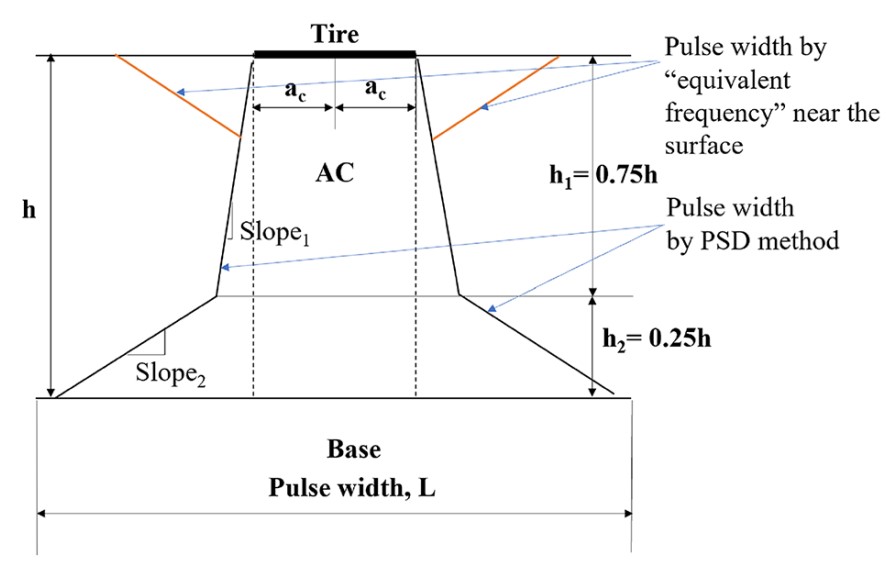
Impact of Equivalent Loading Frequencies on Flexible Pavement Distress Predictions
Peng Chen, Karim Chatti, Bora Cetin, S. Farhad Abdollahi, M. Emin Kutay
Transportation Research Record 2025
The Pavement ME methodology utilizes the concept of equivalent loading frequency to calculate strains within flexible pavement layers through static linear elastic analysis. These calculated strains are then directly used in calculating pavement damage and predicting distresses. Therefore, accurately calculating the loading frequencies is crucial because it can significantly influence pavement performance predictions. In this paper, the effect of loading frequencies on the prediction of long-term pavement distresses is analyzed. Four pavement structures, based on actual freeway designs in Michigan, are selected to examine the effects of loading frequencies on long-term (20-year) pavement distress prediction by comparing rutting and fatigue cracking predicted by the original and corrected Pavement ME frequencies using the Mechanistic-Empirical Pavement Analysis (MEAPA) software. The results show that the difference between bottom-up fatigue cracking predicted by these two frequencies is negligible (<5%), whereas the original Pavement ME frequency underestimates rutting with an error ranging from approximately 15% to 25% for asphalt concrete rutting and from 5% to 10% for total rutting, depending on pavement structures and traffic volumes. The corrected loading frequency method consistently forecasts substantially higher levels of top-down cracking compared with the original Pavement ME, with discrepancies reaching up to 130%. However, it should be noted that the top-down cracking model in MEAPA is based on principal tensile strains near the surface, which is different from the model used in the current Pavement ME model. Nonetheless, there is a potential that the original Pavement ME method may substantially underestimate the extent of top-down fatigue cracking.
Impact of Equivalent Loading Frequencies on Flexible Pavement Distress Predictions
Peng Chen, Karim Chatti, Bora Cetin, S. Farhad Abdollahi, M. Emin Kutay
Transportation Research Record 2025
The Pavement ME methodology utilizes the concept of equivalent loading frequency to calculate strains within flexible pavement layers through static linear elastic analysis. These calculated strains are then directly used in calculating pavement damage and predicting distresses. Therefore, accurately calculating the loading frequencies is crucial because it can significantly influence pavement performance predictions. In this paper, the effect of loading frequencies on the prediction of long-term pavement distresses is analyzed. Four pavement structures, based on actual freeway designs in Michigan, are selected to examine the effects of loading frequencies on long-term (20-year) pavement distress prediction by comparing rutting and fatigue cracking predicted by the original and corrected Pavement ME frequencies using the Mechanistic-Empirical Pavement Analysis (MEAPA) software. The results show that the difference between bottom-up fatigue cracking predicted by these two frequencies is negligible (<5%), whereas the original Pavement ME frequency underestimates rutting with an error ranging from approximately 15% to 25% for asphalt concrete rutting and from 5% to 10% for total rutting, depending on pavement structures and traffic volumes. The corrected loading frequency method consistently forecasts substantially higher levels of top-down cracking compared with the original Pavement ME, with discrepancies reaching up to 130%. However, it should be noted that the top-down cracking model in MEAPA is based on principal tensile strains near the surface, which is different from the model used in the current Pavement ME model. Nonetheless, there is a potential that the original Pavement ME method may substantially underestimate the extent of top-down fatigue cracking.
2024

Comparison of Lab vs. Backcalculated Moduli of Virgin Aggregate and Recycled Aggregate Base Layers
Qasim Zulfiqar, Syed W. Haider, Bora Cetin, Haluk S. Coban, S. Farhad Abdollahi
Applied Science 2024
The resilient modulus (MR) and the backcalculated modulus from the FWD testing (EFWD) of the unbound layers are critical inputs in the analysis/design of pavements. Several studies have tried to develop a conversion factor between these two parameters, while the nonlinear stress dependency of unbound materials and the pavement strain response are mostly missing from the literature. This study aims to compare the laboratory-measured MR of recycled aggregate base (RAB) materials and a virgin aggregate base using field-based EFWD and tries to establish pavement’s responses to loading using vertical strains from both the MR and EFWD values of the respective materials as comparability parameters between the two. For this purpose, a control virgin aggregate (VA, limestone) and three types of RAB materials were selected to construct four test sections. The test sections were modeled in layered elastic- and finite-element-based pavement response models to calculate the vertical strains at the mid-depth of the base and top of the subgrade layers. A comparison of the lab-calculated vertical strains using MR with actual vertical strains in the field from EFWD showed that there was no relationship between the two stiffness parameters in all tested RABs. The vertical strains, based on the lab MR, undermined the stiffness of the recycled aggregates in the field. In contrast, the values of EFWD based on the vertical strains remained close to the MR strains of limestone (VA) throughout the testing period, establishing an EFWD vs. MR relationship (MR = 0.87 EFWD). The results also show that fine RCA was a better-performing material over three years. This research not only explores how the hydration process in RABs limits the development of MR-EFWD correlations but also underscores the need to consider real-world conditions when assessing their performance.
Comparison of Lab vs. Backcalculated Moduli of Virgin Aggregate and Recycled Aggregate Base Layers
Qasim Zulfiqar, Syed W. Haider, Bora Cetin, Haluk S. Coban, S. Farhad Abdollahi
Applied Science 2024
The resilient modulus (MR) and the backcalculated modulus from the FWD testing (EFWD) of the unbound layers are critical inputs in the analysis/design of pavements. Several studies have tried to develop a conversion factor between these two parameters, while the nonlinear stress dependency of unbound materials and the pavement strain response are mostly missing from the literature. This study aims to compare the laboratory-measured MR of recycled aggregate base (RAB) materials and a virgin aggregate base using field-based EFWD and tries to establish pavement’s responses to loading using vertical strains from both the MR and EFWD values of the respective materials as comparability parameters between the two. For this purpose, a control virgin aggregate (VA, limestone) and three types of RAB materials were selected to construct four test sections. The test sections were modeled in layered elastic- and finite-element-based pavement response models to calculate the vertical strains at the mid-depth of the base and top of the subgrade layers. A comparison of the lab-calculated vertical strains using MR with actual vertical strains in the field from EFWD showed that there was no relationship between the two stiffness parameters in all tested RABs. The vertical strains, based on the lab MR, undermined the stiffness of the recycled aggregates in the field. In contrast, the values of EFWD based on the vertical strains remained close to the MR strains of limestone (VA) throughout the testing period, establishing an EFWD vs. MR relationship (MR = 0.87 EFWD). The results also show that fine RCA was a better-performing material over three years. This research not only explores how the hydration process in RABs limits the development of MR-EFWD correlations but also underscores the need to consider real-world conditions when assessing their performance.

UPDAPS-Flood: a mechanistic-empirical flexible pavement analysis tool to evaluate the effect of flooding events on flexible pavement performance
S. Farhad Abdollahi, M. Emin Kutay, M. Lanotte
International Journal of Pavement Engineering (IJPE) 2024
Flooding can cause considerable damage to flexible pavements and negatively affects their performance over time. This study aims to evaluate the flooding effects on the flexible pavement performance and the potential resiliency of the pavement network through a mechanistic-empirical (ME) pavement analysis approach. The Unified Pavement Distress Analysis and Prediction System (UPDAPS) programme, which includes ME analysis models, was used to develop the UPDAPS-Flood programme. A total of 7,655 flexible pavement sections were extracted from the Highway Pavement Management System (HPMS) database in three United States regions. Finally, the resiliency of the pavement network to flood events was quantified using the loss of pavement service life based on the international roughness index (IRI). The results showed that flooding has the highest impact on rutting performance, followed by IRI and fatigue cracking. It has been found that a proper drainage system can reduce the flooding impact by a factor of two. The predicted pavement performance was found to be very sensitive to the coefficients of the rutting model, which brings the need for further studies to re-calibrate the rutting prediction model at higher moisture content levels.
UPDAPS-Flood: a mechanistic-empirical flexible pavement analysis tool to evaluate the effect of flooding events on flexible pavement performance
S. Farhad Abdollahi, M. Emin Kutay, M. Lanotte
International Journal of Pavement Engineering (IJPE) 2024
Flooding can cause considerable damage to flexible pavements and negatively affects their performance over time. This study aims to evaluate the flooding effects on the flexible pavement performance and the potential resiliency of the pavement network through a mechanistic-empirical (ME) pavement analysis approach. The Unified Pavement Distress Analysis and Prediction System (UPDAPS) programme, which includes ME analysis models, was used to develop the UPDAPS-Flood programme. A total of 7,655 flexible pavement sections were extracted from the Highway Pavement Management System (HPMS) database in three United States regions. Finally, the resiliency of the pavement network to flood events was quantified using the loss of pavement service life based on the international roughness index (IRI). The results showed that flooding has the highest impact on rutting performance, followed by IRI and fatigue cracking. It has been found that a proper drainage system can reduce the flooding impact by a factor of two. The predicted pavement performance was found to be very sensitive to the coefficients of the rutting model, which brings the need for further studies to re-calibrate the rutting prediction model at higher moisture content levels.

Development of a Mechanistic-Empirical-Based Highway Cost Allocation Model for Flexible Pavements
S. Farhad Abdollahi, Poornachandra Vaddy, M. Emin Kutay
Transportation Research Record (TRR) 2024
Construction, operation, and maintenance of a pavement network requires funding, partially sourced from road user taxes. Recent studies showed that lightweight vehicles are typically taxed higher compared with heavy trucks that damage the roads the most. To facilitate the equity and fairness of the allocated costs to different vehicles in the United States (U.S.), Highway Cost Allocation Studies (HCAS) were performed using various pavement performance prediction models. Reviewed literature showed the lack of mechanistic-empirical (ME)-based HCAS models for the flexible pavement network. In this study, a national-level ME-based HCAS model was developed, and the damage shares of different vehicle classes have been estimated for 67,583 pavement sections in the U.S. Highway Performance Monitoring System (HPMS) database. The proposed HCAS model was compared with the existing Federal Highway Administration (FHWA) HCAS model (i.e., National Pavement Cost Model [NAPCOM]). The analysis of the traffic data showed that two-axle single-unit trucks (SU2) and tractor-semitrailers with two tandem and one single axle (CS5T) were the most frequent users of the pavement network. The results showed that the damage share of SU2 is dominant in minor roadways, while the damage share of the heavier vehicles in the CS5T class is dominant in major arterials and interstates. In addition, it was found that, although the geographical location and environmental condition of the pavement section affects the magnitude of the pavement distresses, the distribution of the damage shares remains almost the same. This can be attributed to the similarities in the traffic data, for example, vehicle class distribution and axle load spectra.
Development of a Mechanistic-Empirical-Based Highway Cost Allocation Model for Flexible Pavements
S. Farhad Abdollahi, Poornachandra Vaddy, M. Emin Kutay
Transportation Research Record (TRR) 2024
Construction, operation, and maintenance of a pavement network requires funding, partially sourced from road user taxes. Recent studies showed that lightweight vehicles are typically taxed higher compared with heavy trucks that damage the roads the most. To facilitate the equity and fairness of the allocated costs to different vehicles in the United States (U.S.), Highway Cost Allocation Studies (HCAS) were performed using various pavement performance prediction models. Reviewed literature showed the lack of mechanistic-empirical (ME)-based HCAS models for the flexible pavement network. In this study, a national-level ME-based HCAS model was developed, and the damage shares of different vehicle classes have been estimated for 67,583 pavement sections in the U.S. Highway Performance Monitoring System (HPMS) database. The proposed HCAS model was compared with the existing Federal Highway Administration (FHWA) HCAS model (i.e., National Pavement Cost Model [NAPCOM]). The analysis of the traffic data showed that two-axle single-unit trucks (SU2) and tractor-semitrailers with two tandem and one single axle (CS5T) were the most frequent users of the pavement network. The results showed that the damage share of SU2 is dominant in minor roadways, while the damage share of the heavier vehicles in the CS5T class is dominant in major arterials and interstates. In addition, it was found that, although the geographical location and environmental condition of the pavement section affects the magnitude of the pavement distresses, the distribution of the damage shares remains almost the same. This can be attributed to the similarities in the traffic data, for example, vehicle class distribution and axle load spectra.
2023

MatFEA: Efficient Finite Element Framework for Analyzing Pavement Structures With Nonlinear Unbound Materials
S. Farhad Abdollahi, M. Emin Kutay, Mahdi Ghazavi
Transportation Research Record (TRR) 2023
This paper reports the details of a computationally efficient finite element analysis code (called MatFEA), designed specifically for flexible pavements, where stress-dependent characteristics of unbound layers are considered. The stress-dependent nonlinearity of the unbound materials has been modeled in MatFEA through an iterative approach. MatFEA was mainly developed to improve the Mechanistic-Empirical Asphalt Pavement Analysis (MEAPA) web application with capability of analysis/design of nonlinear pavement structures. A specific-purpose mesh generation algorithm was developed for the MatFEA in which the mesh density was dynamically adjustable based on the expected stress magnitude. To verify the results of the MatFEA, 12,000 nonlinear pavement structures with different structural and loading properties were generated and analyzed with MatFEA. The same pavement structures were modeled in a general-purpose FE-based ABAQUS™ program. The results of this study showed that the critical pavement structural responses from the MatFEA were almost identical with those modeled by ABAQUS™ program. The average runtime of MatFEA for analyzing each pavement structure was about 1.13 s. Finally, it was concluded that application of the dynamically adjustable mesh generation algorithm in the MatFEA helped achieve a reasonably high accuracy as well as efficient runtime, which brings the advantage of implementing the MatFEA as a pavement structural response model in the mechanistic-empirical pavement analysis/design procedures.
MatFEA: Efficient Finite Element Framework for Analyzing Pavement Structures With Nonlinear Unbound Materials
S. Farhad Abdollahi, M. Emin Kutay, Mahdi Ghazavi
Transportation Research Record (TRR) 2023
This paper reports the details of a computationally efficient finite element analysis code (called MatFEA), designed specifically for flexible pavements, where stress-dependent characteristics of unbound layers are considered. The stress-dependent nonlinearity of the unbound materials has been modeled in MatFEA through an iterative approach. MatFEA was mainly developed to improve the Mechanistic-Empirical Asphalt Pavement Analysis (MEAPA) web application with capability of analysis/design of nonlinear pavement structures. A specific-purpose mesh generation algorithm was developed for the MatFEA in which the mesh density was dynamically adjustable based on the expected stress magnitude. To verify the results of the MatFEA, 12,000 nonlinear pavement structures with different structural and loading properties were generated and analyzed with MatFEA. The same pavement structures were modeled in a general-purpose FE-based ABAQUS™ program. The results of this study showed that the critical pavement structural responses from the MatFEA were almost identical with those modeled by ABAQUS™ program. The average runtime of MatFEA for analyzing each pavement structure was about 1.13 s. Finally, it was concluded that application of the dynamically adjustable mesh generation algorithm in the MatFEA helped achieve a reasonably high accuracy as well as efficient runtime, which brings the advantage of implementing the MatFEA as a pavement structural response model in the mechanistic-empirical pavement analysis/design procedures.
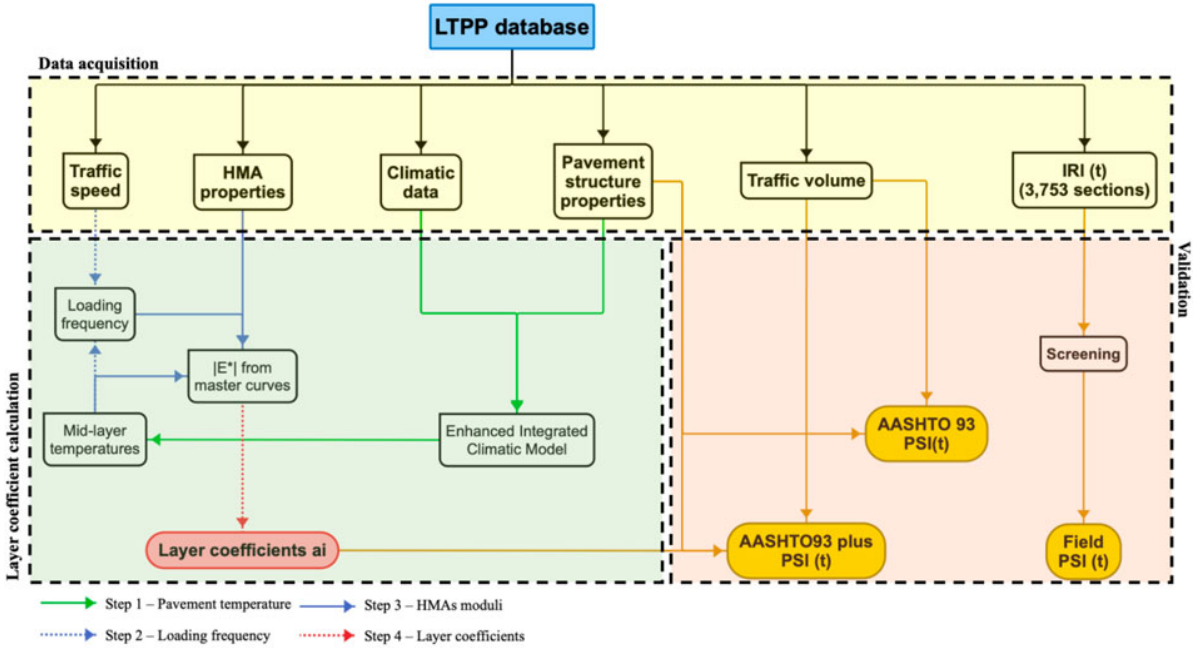
AASHTO 1993 Plus: an alternative procedure for the calculation of structural asphalt layer coefficients
S. Farhad Abdollahi, Michele Lanotte, M. Emin Kutay, Hussain Bahia
International Journal of Pavement Engineering (IJPE) 2023
Many road agencies worldwide still use the empirical AASHTO 1993 pavement design method. Since the release of the AASHTO 1993 design guide, many aspects of pavement design have changed, including asphalt material properties, traffic, environmental factors, etc. However, many agencies use a single layer coefficient for asphalt mixtures and pavements are currently designed with inaccurate values, as proved by many. This paper presents a four-step procedure (called AASHTO 93 Plus method) to determine structural layer coefficients of asphalt mixtures. The AASHTO 93 Plus method considers viscoelasticity and temperature-dependency of asphalt mixtures to estimate the layer coefficient. Five-hundred-eighteen (518) flexible pavements from USA and Canada roads and 1599 HMAs from the Long-Term Pavement Performance (LTPP) database were analyzed. The results showed that the new material-specific layer coefficients were well above the typical value of 0.44. The total number of 3,726 IRI data records of these 518 pavements were converted to PSI and then compared to those obtained from the traditional AASHTO 93 and AASHTO 93 Plus methods for validation. Results confirmed that the conventional AASHTO 93 method predicts faster deterioration of pavement conditions over time, while the results of AASHTO 93 Plus method better aligned with the field data.
AASHTO 1993 Plus: an alternative procedure for the calculation of structural asphalt layer coefficients
S. Farhad Abdollahi, Michele Lanotte, M. Emin Kutay, Hussain Bahia
International Journal of Pavement Engineering (IJPE) 2023
Many road agencies worldwide still use the empirical AASHTO 1993 pavement design method. Since the release of the AASHTO 1993 design guide, many aspects of pavement design have changed, including asphalt material properties, traffic, environmental factors, etc. However, many agencies use a single layer coefficient for asphalt mixtures and pavements are currently designed with inaccurate values, as proved by many. This paper presents a four-step procedure (called AASHTO 93 Plus method) to determine structural layer coefficients of asphalt mixtures. The AASHTO 93 Plus method considers viscoelasticity and temperature-dependency of asphalt mixtures to estimate the layer coefficient. Five-hundred-eighteen (518) flexible pavements from USA and Canada roads and 1599 HMAs from the Long-Term Pavement Performance (LTPP) database were analyzed. The results showed that the new material-specific layer coefficients were well above the typical value of 0.44. The total number of 3,726 IRI data records of these 518 pavements were converted to PSI and then compared to those obtained from the traditional AASHTO 93 and AASHTO 93 Plus methods for validation. Results confirmed that the conventional AASHTO 93 method predicts faster deterioration of pavement conditions over time, while the results of AASHTO 93 Plus method better aligned with the field data.
2022
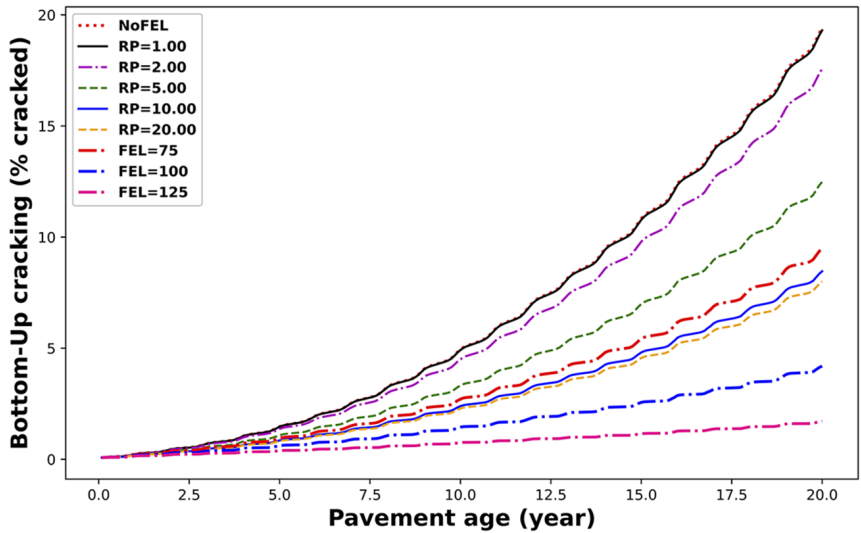
Implementation of NCHRP 9-44A Fatigue Endurance Limit Prediction Model in Mechanistic-Empirical Asphalt Pavement Analysis Web Application
Mahdi Ghazavi, S. Farhad Abdollahi, M. Emin Kutay
Transportation Research Record (TRR) 2022
One of the essential components of various design methods for perpetual (or long-life) flexible pavements is elimination (or minimization) of bottom-up fatigue cracking. For this purpose, the concept of the fatigue endurance limit (FEL) is used. The FEL is defined as a strain threshold below which fatigue damage does not accumulate for any number of load repetitions. Different ranges of FEL values have been reported in the literature. Recent studies have showed that FEL is not a single value and depends on several factors. The NCHRP 9-44A project resulted in an FEL prediction model based on the micro-crack healing concept and stiffness, both of which can fluctuate throughout the service life of a pavement. In this study, NCHRP 9-44A FEL prediction model was implemented in the Mechanistic-Empirical Asphalt Pavement Analysis (MEAPA) web application to investigate the effect of fluctuating FEL on bottom-up fatigue cracking prediction in three typical road sections (low, medium, and high traffic) in Michigan. The critical bottom-up fatigue strains, predicted FEL, and predicted fatigue cracking for each road section have been compared. The results revealed that implementation of FEL is critical for accuracy in the prediction of fatigue cracking in relatively thick pavements that are subjected to high traffic loading. The effect of FEL, however, was minimal in thin pavements with low traffic levels. Therefore, given that the mechanistic-empirical pavement design methods are typically used while designing highly trafficked pavements (e.g., highways, arterials, etc.), proper implementation of the FEL concept in pavement design is very important.
Implementation of NCHRP 9-44A Fatigue Endurance Limit Prediction Model in Mechanistic-Empirical Asphalt Pavement Analysis Web Application
Mahdi Ghazavi, S. Farhad Abdollahi, M. Emin Kutay
Transportation Research Record (TRR) 2022
One of the essential components of various design methods for perpetual (or long-life) flexible pavements is elimination (or minimization) of bottom-up fatigue cracking. For this purpose, the concept of the fatigue endurance limit (FEL) is used. The FEL is defined as a strain threshold below which fatigue damage does not accumulate for any number of load repetitions. Different ranges of FEL values have been reported in the literature. Recent studies have showed that FEL is not a single value and depends on several factors. The NCHRP 9-44A project resulted in an FEL prediction model based on the micro-crack healing concept and stiffness, both of which can fluctuate throughout the service life of a pavement. In this study, NCHRP 9-44A FEL prediction model was implemented in the Mechanistic-Empirical Asphalt Pavement Analysis (MEAPA) web application to investigate the effect of fluctuating FEL on bottom-up fatigue cracking prediction in three typical road sections (low, medium, and high traffic) in Michigan. The critical bottom-up fatigue strains, predicted FEL, and predicted fatigue cracking for each road section have been compared. The results revealed that implementation of FEL is critical for accuracy in the prediction of fatigue cracking in relatively thick pavements that are subjected to high traffic loading. The effect of FEL, however, was minimal in thin pavements with low traffic levels. Therefore, given that the mechanistic-empirical pavement design methods are typically used while designing highly trafficked pavements (e.g., highways, arterials, etc.), proper implementation of the FEL concept in pavement design is very important.
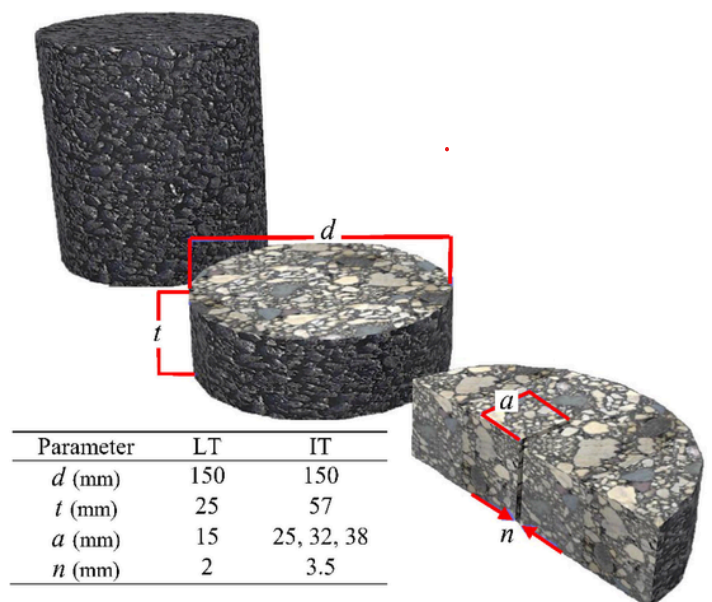
Cracking performance of rubberized RAP mixtures with Sasobit
S. Farhad Abdollahi, Mohammad M. Karimi, Hamid Jahanbakhsh, Nader Tabatabaee
Construction and Building Materials (CBM) 2022
Incorporation of reclaimed asphalt pavement (RAP) and crumb rubber (CR) materials into asphalt mixtures have been of great importance from sustainability point of view. Although, inclusion of RAP materials in asphalt mixtures improves the rutting resistance at high temperature, the low temperature (LT) and intermediate temperature (IT) cracking performance of RAP mixtures may need additional considerations. In this regard, different schemes of modification have been applied to RAP mixtures to address its performance weaknesses. This study evaluated the effect of RAP and CR in combination with Sasobit and hydrated lime on the cracking performance of asphalt mixtures. The LT and IT semi-circular bending (SCB) tests showed that up to 15% CR modification improved the cracking resistance. However, at 18% CR fatigue performance of the RAP mixture slightly declined. This is attributed to the insufficient binder content in the asphalt mixture leading to the reduced fatigue performance of the mixture. The results also emphasized the use of WMA additive, as workability promoter, for improving the IT cracking performance of rubberized RAP mixtures. Finally, an overall assessment approach was utilized to select the asphalt mixture with best overall performance while upholding the sustainability considerations. In this regard, the combined application of Sasobit and CR modification to the RAP mixtures resulted in an overall better performance compared to that of the control mixture.
Cracking performance of rubberized RAP mixtures with Sasobit
S. Farhad Abdollahi, Mohammad M. Karimi, Hamid Jahanbakhsh, Nader Tabatabaee
Construction and Building Materials (CBM) 2022
Incorporation of reclaimed asphalt pavement (RAP) and crumb rubber (CR) materials into asphalt mixtures have been of great importance from sustainability point of view. Although, inclusion of RAP materials in asphalt mixtures improves the rutting resistance at high temperature, the low temperature (LT) and intermediate temperature (IT) cracking performance of RAP mixtures may need additional considerations. In this regard, different schemes of modification have been applied to RAP mixtures to address its performance weaknesses. This study evaluated the effect of RAP and CR in combination with Sasobit and hydrated lime on the cracking performance of asphalt mixtures. The LT and IT semi-circular bending (SCB) tests showed that up to 15% CR modification improved the cracking resistance. However, at 18% CR fatigue performance of the RAP mixture slightly declined. This is attributed to the insufficient binder content in the asphalt mixture leading to the reduced fatigue performance of the mixture. The results also emphasized the use of WMA additive, as workability promoter, for improving the IT cracking performance of rubberized RAP mixtures. Finally, an overall assessment approach was utilized to select the asphalt mixture with best overall performance while upholding the sustainability considerations. In this regard, the combined application of Sasobit and CR modification to the RAP mixtures resulted in an overall better performance compared to that of the control mixture.
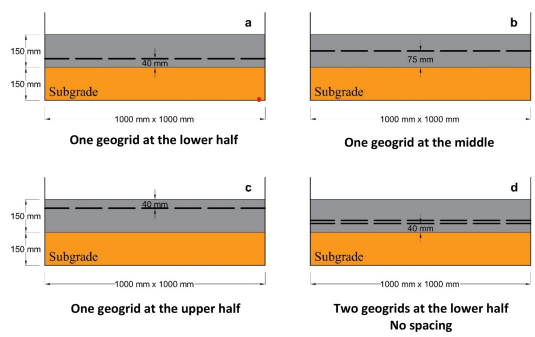
Investigating the performance of geogrid reinforced unbound layer using light weight deflectometer (LWD)
Mohammadreza Sabouri, Sahand Khabiri, S. Mohammad Asgharzadeh, S. Farhad Abdollahi
International Journal of Pavement Research and Technology (IJPRT) 2022
This study investigates the performance of geogrid-reinforced unbound pavement layer. In this study, geogrid was used in various layouts and numbers using three different gradation of granular materials. Light weight deflectometer (LWD) device is known as a useful tool to evaluate the stiffness of unbound pavement layers. In this study, the LWD was utilized to experimentally investigate factors affecting the performance of geogrid reinforcement, including the number of geogrids, geogrid layout, and the gradation of unbound layer. There are several parameters which affect the LWD test results including the hammer weight, the falling height, and the surface stress. The effect of these parameters was also investigated. The results indicated that the improving effect of geogrid reinforcement is highly dependent upon the gradation of unbound layer. Incorporation of geogrid on the well-graded unbound layer decreased the elastic modulus; while, improving effect of geogrid reinforcement was observed on coarse and gap-graded unbound layers. It was also shown that geogrid reinforcement shows the best performance when one geogrid layer is installed at the bottom half of the unbound layer. The results of the LWD test showed that the LWD measurement at a particular hammer weight and falling height could be calibrated to a standard setting using the hammer's gravitational energy concept.
Investigating the performance of geogrid reinforced unbound layer using light weight deflectometer (LWD)
Mohammadreza Sabouri, Sahand Khabiri, S. Mohammad Asgharzadeh, S. Farhad Abdollahi
International Journal of Pavement Research and Technology (IJPRT) 2022
This study investigates the performance of geogrid-reinforced unbound pavement layer. In this study, geogrid was used in various layouts and numbers using three different gradation of granular materials. Light weight deflectometer (LWD) device is known as a useful tool to evaluate the stiffness of unbound pavement layers. In this study, the LWD was utilized to experimentally investigate factors affecting the performance of geogrid reinforcement, including the number of geogrids, geogrid layout, and the gradation of unbound layer. There are several parameters which affect the LWD test results including the hammer weight, the falling height, and the surface stress. The effect of these parameters was also investigated. The results indicated that the improving effect of geogrid reinforcement is highly dependent upon the gradation of unbound layer. Incorporation of geogrid on the well-graded unbound layer decreased the elastic modulus; while, improving effect of geogrid reinforcement was observed on coarse and gap-graded unbound layers. It was also shown that geogrid reinforcement shows the best performance when one geogrid layer is installed at the bottom half of the unbound layer. The results of the LWD test showed that the LWD measurement at a particular hammer weight and falling height could be calibrated to a standard setting using the hammer's gravitational energy concept.
2020

Development of a Computer Program for Calculation of the Alpha Parameter in the Linear Amplitude Sweep Test and Comparison with Rheological Parameters
S. Farhad Abdollahi, Mehdi Farrokhi, Nader Tabatabaee
Transportation Research Record (TRR) 2020
Characterizing and modeling the fatigue performance of an asphalt binder is important when designing asphalt mixtures which can resist premature fatigue failure. Performance grading (PG) standards include the fatigue factor (G*.sinδ) to evaluate the fatigue resistance of asphalt binders. This criterion seems to be inaccurate, especially when applied to modified asphalt binders. American Association of State Highway and Transportation Officials (AASHTO) TP 101 has been designed to evaluate the fatigue resistance of asphalt binders using Schapery’s work potential theory. The damage evolution rate (α parameter) is the key element of this method and is calculated from the rheological properties of the undamaged asphalt binder using the slope of the relaxation modulus versus the time on the log-log scale. Owing to the difficulties of conducting the relaxation test, the relaxation modulus is usually obtained using conversion methods. However, AASHTO TP 101 uses a simplified indirect method to calculate α. The present study developed a computer program called RheoSUT with which to construct relaxation master curves using different methods. The relaxation master curves of 27 asphalt binders were evaluated for estimation of the value of α. The results indicated that AASHTO TP 101 yields higher values of α. The results of the sensitivity analysis show that overestimation of α will result in up to about 200% error in the estimation of the fatigue life (Nf). It is also shown that binder aging and styrene-butadiene-styrene (SBS) modification directly affected the rheological parameters and relaxation master curves. Finally, it is recommended to use the relaxation-master curved based methods of calculation of α instead of the storage-modulus based ones.
Development of a Computer Program for Calculation of the Alpha Parameter in the Linear Amplitude Sweep Test and Comparison with Rheological Parameters
S. Farhad Abdollahi, Mehdi Farrokhi, Nader Tabatabaee
Transportation Research Record (TRR) 2020
Characterizing and modeling the fatigue performance of an asphalt binder is important when designing asphalt mixtures which can resist premature fatigue failure. Performance grading (PG) standards include the fatigue factor (G*.sinδ) to evaluate the fatigue resistance of asphalt binders. This criterion seems to be inaccurate, especially when applied to modified asphalt binders. American Association of State Highway and Transportation Officials (AASHTO) TP 101 has been designed to evaluate the fatigue resistance of asphalt binders using Schapery’s work potential theory. The damage evolution rate (α parameter) is the key element of this method and is calculated from the rheological properties of the undamaged asphalt binder using the slope of the relaxation modulus versus the time on the log-log scale. Owing to the difficulties of conducting the relaxation test, the relaxation modulus is usually obtained using conversion methods. However, AASHTO TP 101 uses a simplified indirect method to calculate α. The present study developed a computer program called RheoSUT with which to construct relaxation master curves using different methods. The relaxation master curves of 27 asphalt binders were evaluated for estimation of the value of α. The results indicated that AASHTO TP 101 yields higher values of α. The results of the sensitivity analysis show that overestimation of α will result in up to about 200% error in the estimation of the fatigue life (Nf). It is also shown that binder aging and styrene-butadiene-styrene (SBS) modification directly affected the rheological parameters and relaxation master curves. Finally, it is recommended to use the relaxation-master curved based methods of calculation of α instead of the storage-modulus based ones.